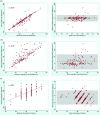Validation of a wearable biosensor device for vital sign monitoring in septic emergency department patients in Rwanda
- PMID: 31632685
- PMCID: PMC6769214
- DOI: 10.1177/2055207619879349
Validation of a wearable biosensor device for vital sign monitoring in septic emergency department patients in Rwanda
Abstract
Objective: Critical care capabilities needed for the management of septic patients, such as continuous vital sign monitoring, are largely unavailable in most emergency departments (EDs) in low- and middle-income country (LMIC) settings. This study aimed to assess the feasibility and accuracy of using a wireless wearable biosensor device for continuous vital sign monitoring in ED patients with suspected sepsis in an LMIC setting.
Methods: This was a prospective observational study of pediatric (≥2 mon) and adult patients with suspected sepsis at the Kigali University Teaching Hospital ED. Heart rate, respiratory rate and temperature measurements were continuously recorded using a wearable biosensor device for the duration of the patients' ED course and compared to intermittent manually collected vital signs.
Results: A total of 42 patients had sufficient data for analysis. Mean duration of monitoring was 32.8 h per patient. Biosensor measurements were strongly correlated with manual measurements for heart rate (r = 0.87, p < 0.001) and respiratory rate (r = 0.75, p < 0.001), although were less strong for temperature (r = 0.61, p < 0.001). Mean (SD) differences between biosensor and manual measurements were 1.2 (11.4) beats/min, 2.5 (5.5) breaths/min and 1.4 (1.0)°C. Technical or practical feasibility issues occurred in 12 patients (28.6%) although were minor and included biosensor detachment, connectivity problems, removal for a radiologic study or exam, and patient/parent desire to remove the device.
Conclusions: Wearable biosensor devices can be feasibly implemented and provide accurate continuous heart rate and respiratory rate monitoring in acutely ill pediatric and adult ED patients with sepsis in an LMIC setting.
Keywords: Rwanda; Sepsis; biosensor; continuous vital signs; critical care; emergency medicine; low- and middle-income country; resource-limited; wearable device; wearable technology.
© The Author(s) 2019.
Figures


Similar articles
-
A novel digital health approach to improving global pediatric sepsis care in Bangladesh using wearable technology and machine learning.PLOS Digit Health. 2024 Oct 30;3(10):e0000634. doi: 10.1371/journal.pdig.0000634. eCollection 2024 Oct. PLOS Digit Health. 2024. PMID: 39475844 Free PMC article.
-
Advantage of Vital Sign Monitoring Using a Wireless Wearable Device for Predicting Septic Shock in Febrile Patients in the Emergency Department: A Machine Learning-Based Analysis.Sensors (Basel). 2022 Sep 17;22(18):7054. doi: 10.3390/s22187054. Sensors (Basel). 2022. PMID: 36146403 Free PMC article.
-
Reliability of a wearable wireless patch for continuous remote monitoring of vital signs in patients recovering from major surgery: a clinical validation study from the TRaCINg trial.BMJ Open. 2019 Aug 15;9(8):e031150. doi: 10.1136/bmjopen-2019-031150. BMJ Open. 2019. PMID: 31420399 Free PMC article. Clinical Trial.
-
Current Evidence for Continuous Vital Signs Monitoring by Wearable Wireless Devices in Hospitalized Adults: Systematic Review.J Med Internet Res. 2020 Jun 17;22(6):e18636. doi: 10.2196/18636. J Med Internet Res. 2020. PMID: 32469323 Free PMC article.
-
Patient acceptability of wearable vital sign monitoring technologies in the acute care setting: A systematic review.J Clin Nurs. 2019 Aug;28(15-16):2732-2744. doi: 10.1111/jocn.14893. Epub 2019 May 9. J Clin Nurs. 2019. PMID: 31017338
Cited by
-
Digital Health Technologies for Maternal and Child Health in Africa and Other Low- and Middle-Income Countries: Cross-disciplinary Scoping Review With Stakeholder Consultation.J Med Internet Res. 2023 Apr 7;25:e42161. doi: 10.2196/42161. J Med Internet Res. 2023. PMID: 37027199 Free PMC article.
-
Wearable devices for patient monitoring in the intensive care unit.Intensive Care Med Exp. 2025 Feb 27;13(1):26. doi: 10.1186/s40635-025-00738-8. Intensive Care Med Exp. 2025. PMID: 40016479 Free PMC article. Review.
-
Adverse effects of temperature on perinatal and pregnancy outcomes: methodological challenges and knowledge gaps.Front Public Health. 2023 Nov 1;11:1185836. doi: 10.3389/fpubh.2023.1185836. eCollection 2023. Front Public Health. 2023. PMID: 38026314 Free PMC article. Review.
-
Accuracy and reliability of a wireless vital signs monitor for hospitalized patients in a low-resource setting.Digit Health. 2022 May 26;8:20552076221102262. doi: 10.1177/20552076221102262. eCollection 2022 Jan-Dec. Digit Health. 2022. PMID: 35656284 Free PMC article.
-
Parental perceptions of a wearable vital signs monitor for observation of newborns: in-depth interviews in three tertiary hospitals, Southwest Nigeria.Front Digit Health. 2025 Jul 28;7:1597651. doi: 10.3389/fdgth.2025.1597651. eCollection 2025. Front Digit Health. 2025. PMID: 40791998 Free PMC article.
References
-
- Fleischmann C, Scherag A, Adhikari NKJ, et al. Assessment of global incidence and mortality of hospital-treated sepsis. Current estimates and limitations. Am J Respir Crit Care Med 2016; 193: 259–272. - PubMed
-
- Machado FR, Angus DC. Trying to improve sepsis care in low-resource settings. JAMA 2017; 318: 1225–1227. - PubMed
-
- Murthy S, Adhikari NK. Global health care of the critically ill in low-resource settings. Ann Am Thorac Soc 2013; 10: 509–513. - PubMed
LinkOut - more resources
Full Text Sources

